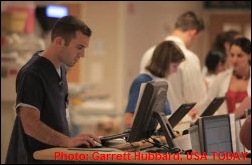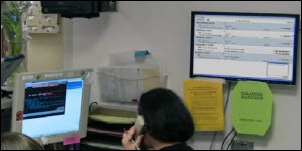Giving a patient medications in the ER, having them pop positive on a test, and then withholding further medications because…
News 10/9/09
From Bush vs. Tullman: “Re: Health 2.0. Was at Health 2.0 for the Jonathan Bush and Glen Tullman panel. Bush came out in red boxing shorts and a blazer! I will say Bush and Kibbe made some good points. Was disappointed that Tullman didn’t even show and came via teleconference.” Maybe Glen shares my belief that if it’s really 2.0, it shouldn’t require hauling in a ton of carbon-burning attendees to sit in a room together to watch oddly named startups hoping to find buyers for their no-revenue companies — err, helping empower patients via the Internet. Still, it sounds like fun. I’d rather have the noobs pitch their businesses to a panel of money guys, like my semi-favorite show Shark Tank (“You’re dead to me now.”) Maybe I can get rich guys like JB and Glen to be on an HIStalk shark panel at HIMSS and they could actually invest in some HIT bootstrapper’s venture.
The response to a USA Today article on medical scribes is getting me riled up, with smug know-it-alls weighing in with uninformed comments like these: “I guess the older doctors who aren’t computer literate need scribes.” I’m trying hard to censor the profanities that I’m itching to write. Do you think less of your “younger” CPA if he or she isn’t typing into your 1040 form while you’re talking? Would you be happier if your lawyer stared at a PC screen instead of the jury? Does the President tickle the ivories on a laptop sitting in front of him while meeting with heads of state? Do even Steve Jobs and Steve Ballmer type their own meeting minutes while running Apple and Microsoft? Sure, the information needs to be entered into the EMR, but who says the doctor has do their own typing to get it there? Kiss your EMRs-for-everybody plans goodbye if the best method you can come up with is having doctors do all the data entry, the only highly paid professionals shamed into using tools whose benefit they question just because someone else thinks it’s a good idea (why not make patients enter their own information into a PHR? or schedule their appointments and ED visits on the Web? Or, for that matter, eliminate their own financial “scribes” and pay doctors by credit card before leaving the office?)
Law firms chosen to represent the state of New York in class action suits are heavy donors to state controllers. Among the “pay to play” firms is the one that made $80 million in engineering McKesson HBOC’s $1 billion settlement.
Medical City (TX) goes live with the On-Cue patient itinerary system, a NASA-developed, AI-driven resource optimization system that servers as the “air traffic controller” for getting inpatients and outpatients where they need to be as orders and department backlogs change. I’m impressed with the credentials of the execs (former NASA and Philips people, with even the sales VP holding two master’s degrees from excellent schools).
The VA and DOD have finished the first of three phases of the military’s lifetime record program, the VA CIO says, making their systems interoperable. Phase II is making the records available on NHIN and Phase III involves making all information available during care delivered anywhere and at any time.
A reporter from one of the biggest national newspapers e-mailed to ask if I have examples of vendor non-disclosure contract language as mentioned in Ross Koppel’s interview. I’ll be the anonymous middleman if you can e-mail me examples (or use the Rumor Report form to your right, which accepts attachments like a contract scan).
Cerner keeps getting press for its H1N1 reporting project, which some lazy newspapers are reporting as some kind of exclusive arrangement initiated by Uncle Sam. I had mentioned that the Feds won’t get much data from big academic medical centers unless Epic jumps on board, to which Sunquest e-mailed me to mention that 60% of Epic’s customers and over 70 academic medical centers run LISs from Sunquest, which has been reporting infectious disease data to CDC and states since 2005.
A new HIMSS Analytics report (warning: PDF) says hospitals will struggle to meet ARRA funding requirements, with less than 25% of them live on nursing clinical decision support needed to track measurements such as A1c diabetics under control, smokers offered cessation counseling, and patients receiving VTE prophylaxis. This is an excellent, meaty report that crosswalks system capabilities to ARRA requirements and shows where the industry stands in having the necessary systems implemented. If you are a CIO whose hospital plans to collect stimulus money (or a hospital systems vendor), you should study the expected criteria and how your hospital compares nationally. Some hospital bed ranges have only single-digit penetration of systems that will probably be needed, meaning they had better get on the stick if they want handouts.
Lots of events have been posted to the HIStalk Events Calendar, which also lists events on the main page of HIStalk. You can add yours (free).
Like today’s posting? Add your e-mail address to the Subscribe to Updates box to your upper right and you’ll be the first to know whatever’s important. You might be surprised by the number of e-mails I get from people who thank me for (a) giving them an intense introduction to how the healthcare IT industry really works; (b) reporting some piece of information that made or saved them millions; or (c) making them feel more connected to the industry while traveling. You would spend hours a day to get the information you get here in minutes (and some of what’s here isn’t available anywhere else). The downside is that you may find me annoying, but hopefully that’s a trade worth making (and there’s always Inga as the sweet, sexy one in any case).
Speaking of handouts, they’ve driven us to this kind of headline: Kidney patients, job creation are focus of e-records initiative. University of Buffalo’s practice plan and Computer Task Group embark on a $29 million project ($7 million coming from the state), that “should improve health care.” It sounds like a separate project from the HIE announced there a few weeks ago, but I’m not sure since the practice plan is involved with both.
A hospital in Wales selects a Web-based diabetes care management tool from Hicom Technology.
The Y-12 National Security Complex in Oak Ridge, TN licenses EMBOS, an EMR developed for its 4,500 employees, to Healthcare Technology Partners LLC. The system was developed for Y-12 to help the Department of Energy meet the government’s EMR push. I found nothing on the company, other than it was started by former Y-12 executives.
The mysterious HisserVideo e-mailed to say that he (or she) posted two more funny HIT cartoon videos. CIO: “Didn’t you just send me a press release about a 30-hospital group implementing Super-2000? How could it work for them?” Sales Guy Steve: “Those hospitals are in El Salvador and we sort of just gave it away to get a tax break to offset profits on our Salvadoran coffee business.” He worked my Vision Center observations into the third video, with Sales Guy Steve explaining its expansion: “We are taking over the space where we used to have the QA team.” Sales Guy Steve responds to the product expert’s observation that he knows little about his client except their bed count: “Because I was once having dinner with Bob [the CIO] and the bottle of wine was $414 and Bob said that was funny because they have 414 beds. Pretty neat that I remembered that, huh?” You can add comments to the YouTube page suggesting future installments.
Sentillion is placed in the “visionaries” quadrant of Gartner’s Magic Quadrant for User Provisioning, even more impressive considering that Sentillion was the only healthcare-specific vendor evaluated. That jogged my memory to go back and re-read my interview with Sentillion co-founder and CEO Rob Seliger from two years ago. “People often say that healthcare is slow to adopt technology, yet you can look at the amazing equipment from imaging systems to robotic surgery that is used. I don’t see a fear of technology in healthcare, just an avoidance of technology that’s an impediment to healthcare delivery. Vendors often miss that. We work really hard to get that right.”
It’s a good time to be an HIT vendor shareholder, at least if you bought at the right time. Above is a chart comparing Cerner (blue), Eclipsys (red), Allscripts (green), and the S&P 500 (gold) for the past 12 months. If you had the foresight to buy at the lowest price in the previous year and sold today, your money would have more than doubled with Cerner, nearly tripled with Eclipsys, and quadrupled with Allscripts.
The Toronto Star dissects the ambitious Smart Systems for Health initiative, which started out with grand ideas that turned into a money pit. By 2005, the agency had spent $260 million but accomplished little, triggering an operational review that characterized it as poorly regarded, short on strategic direction, and subject to inadequate oversight. By then the tab had run up to $458 million and the agency had over 300 employees. A year ago, it was dissolved and replaced by eHealth Ontario, now the subject of its own accusations of bloat, wasteful spending, and underachievement. The total now stands at over $1 billion. On Wednesday, Health Minister David Caplan resigned the day before an auditor’s “scathing” report criticizing the project was released. The auditors also uncovered government executive pay problems, where salaries were funneled through local hospitals to bypass government salary limits. Former CEO Sarah Kramer provides a statement that says, basically, that she was on the hook for quick results, the board knew exactly what she was doing, and, while people think a lot of money was wasted under her watch, it was a fraction compared to the amount that was blown before she took the job.
It didn’t take long for the lawyers to jump on the Broward General “reused IV” newspaper article. A personal injury law firm is “taking a proactive stance” to “educate and protect”. Translation: they opened 24-hour-a-day call center offering “free legal advice” from a “legal intake professional” (which I would guess means an offshore call center rep). Apparently the firm is a fixture on daytime TV in South Florida, or as one local puts it, “They are most ubiquitous during Unemployment TV (AKA, the morning talk shows, soap operas, and early afternoon game shows).”
The Wall Street Journal sees opportunity for vendors like Apple and RIM as hospitals replace pagers with smart phones. The article mentions a Stanford trial of accessing Epic on the iPhone, UPMC’s giving doctors and nurses BlackBerrys, and THR Presbyterian’s use of AirStrip OB.
Another Missouri hospital outsources application hosting to Cerner, this time Heartland Health. Eight hospital employees are being canned as a result, apparently.
Forbes profiles Epic. “But the hottest company in the electronic medical records industry is a secretive Wisconsin outfit called Epic Systems. It does little marketing or advertising, shuns acquisitions, never issues press releases and tries to stay out of the headlines. The privately owned company admits it once put up a billboard that said ‘Marketing Sucks … Epic Systems.’” It quotes KLAS as saying Epic is winning 40% of big-hospital sales, which seems low to me since I almost never hear of anyone else selling a big site.

Meditech’s Fall River building wins a design award from the New England chapter of the American Institute of Architects.
Gaile Hinte of HIMformatics is elected president of the North Carolina Healthcare Information and Communications Alliance.
Inland Northwest Health Services (WA) is suing Deaconess Medical Center in a dispute over who owns its Meditech software license.
Big lawsuit verdict: a 24-year-old college graduate claims she lacks motor skills due to improper hospital resuscitation during her birth in 1984. The jury awards her $43.5 million from 40-bed Bellevue Hospital (NY), since taken over by Ellis Hospital. The doctor already settled out of court.
Yale University Health Services admits that several of its employees inappropriately looked at the electronic medical records of murdered pharmacology student Annie Le before they could be sealed.
Odd: a German banker downloads a fake Oxford medical degree and performs 190 hospital surgeries, including amputations, in 14 months before finally getting caught. He was promoted at the hospital despite having misspelled both “doctor” and “medicine” on his fake degree.
Cleveland Clinic predicts the most influential emerging medical technologies for 2010. None involve IT.
HERtalk by Inga
From Maathai: “Re: MGMA must-have trinkets. We will be handing out cards for people to ‘Plant a Tree’. They take the card, log on to a Web site, and select one of 16 countries where Seed the Future has a reforestation project going. We are hoping to have 1,000 trees planted before the end of the year. We also have recycled cardboard pens, but I don’t think they are as exciting as planting trees.” I’ll definitely be popping over to The Origins Healthcare Solutions booth (1006) to help make the world a greener place. Maathai also noted they are handing out stickers and will randomly hand out $50 bills to people wearing the stickers. That’s the kind of green I’m talking about.
From Ernestine: “Re: Health 2.0 conference. Lots of payer and consumer market here. So far it is a disappointment. Sitting in a session now and half are gone, even with cocktails to follow, and it is the first full day.”
From Dr. Love: “Re: Health 2.0 and Jonathan Bush. I don’t think we fully understand what he is wearing. He’s a strange dude.” athenahealth’s Jonathan Bush and Allscripts’ Glen Tullman participated in a “Cats and Dogs” panel, which was suppose to pit “major IT vendors” and Web-based “clinical groupware” vendors. The athena folks tell me that JB was having a little fun with the whole show-down theme and was wearing his boxing shorts. I’m looking forward to seeing the video.
While at the Health 2.0 conference, MDLiveCare announces it will be the first telehealth company to partner with Google Health. The partnership includes the exchange of medical data between MDLiveCare and the Google Health PHR.
Just days after announcing its purchase of Perot Systems, Dell says it’s closing a desktop computing plan in Winston-Salem, NC. Six hundred people will lose their jobs next month, and another 300 by the end of January.
In a more positive announcement, Dell reveals plans for a new smart phone using Google software and running on the AT&T cellular network. The phone will use Google’s Android operating system.
Voalte, our favorite pink pants-wearing vendor, announces the results of its pilot installation with Sarasota Memorial Hospital. Using Voalte’s iPhone-based voice, alarm, and texting product, Sarasota’s nurses were able to provide faster response times for patients and reduce overhead paging by 78%.
CCHIT announces that vendors and developers can start applying for modular certification programs focused on meeting meaningful use requirements. The Preliminary ARRA 2011 program is limited to meaningful use standards spelled out in the ARRA legislation and will provide a certification label identifying which objectives the EHR technology supports. CCHIT is also launching its 2011 Certification program.
MedicAlert Foundation teams with SNOMED Terminology Solutions to provide SNOMED CT controlled medical vocabulary as part of its MedicAlert EMIR service.
David Blumenthal tells an AHIMA audience that the growth of EHR will create at least 50,000 new positions in HIT.








Glen is slick. Stock jumped 400%. He advises the Big O. He is getting a cut of the $ billions from the taxpayers. Why should he show?
Don’t be too fast to disregard all of the companies presenting a the recent Health 2.0 event. Sure, many will fail but there are also some extremely interesting developments occurring that can not be ignored such as the consumer-driven clinical trials study by PatientsLikeMe that had far more data than the official clinical trial, done in Italy and found that the Italian study came up with incorrect findings. This type of thing could have a dramatic impact on how we conduct clinical trials.
Also, San Francisco is a nice place to visit, the weather was beautiful. Do I detect a slight bit of envy on the part of Sir HIStalk?
Your comments regarding the use of scribes is very relevant. However, I couldn’t tell if you were implying that doctors should not do some of their own data entry. Many ED physicians who use scribes also enter their own orders or use voice recognition for their narrative. Tablet PCs are also finding a place with docs. It seems that the lines are blurring and there are mulitple options that can fit physician workflow and preferences.
[From Mr. HIStalk] I believe that, like any other highly educated professionals, doctors should enter their own specific data elements (a) if they want to, or (b) if their employer wants them to. That leaves those most intimately involved to decide for themselves where it makes sense. I’ve seen few real, practicing, non-IT doctors who enter their own data and publicly proclaim that all their peers should do the same because it’s so great. It’s non-doctors who want to make that decision for them, utterly convinced that typing doctors are better doctors. Professionals have no disincentive to choose tools that make them more effective and productive. If they aren’t convinced that today’s tools do that, that’s their business (literally). I’ve asked several HIT industry bigwigs if they would drop their current doctor just because he or she doesn’t use an EMR; I’ve yet to have one say yes.
I am amazed how many people just didn’t get the Jonathan Bush joke. Glen Tullman couldn’t appear live because his son (yes the one who has diabetes) had a football game rescheduled for the same day, and Glen has a personal commitment to his family to never miss those games. However, he also committed to me and Health 2.0 to do this panel. I would much rather he’d been there in person, not least because the video link (which wasnt perfect) cost about the same as a Gold sponsorship to HISTalk….and way way more than both an air ticket and any carbon offsets we’d have bought!!
But when they found out that Glen would only be on the big screen, the athenahealth folks thought that it would be funny to ape the most famous commercial of all time–the Apple “1984” commercial in which the woman in red shorts hurls a hammer into the video screen of the figure representing IBM….so Bush ran onstage in red shorts and hurled a nerfball at Glen’s image on the big screen.
All amusing fun I thought….in an industry where fun ain’t exactly in large supply
What everyone seems to have missed that was way more controversial was Tullman explicitly going after Epic for standing in the way of interoperability. AND decrying the move from CCHIT and HHS to move to what he called weaker standards.
Re: The response to a USA Today article on medical scribes
You are absolutely right – I took my daughter to the ER recently, and the “young” attending physician spent most of the time looking at the computer screen and typing information instead of paying attention to my daughter who was seriously compromised with an asthma attack. She was so focused on the task of updating the EMR that she was only half listening. In addition to making me repeat the same information several times, she missed that my daughter’s lips were turning blue and I had to ask her to please check my daughter’s vitals! Someone please explain to me how this improves patient care? This was not only completely unprofessional, but also alarming.
About scribes.. your argument is spurious comparing how one president of the US behaves compared to the one million doctors in the US. Likewise, there are only a handful of megalo-maniac CEOs like Steve Jobs and Steve Balmer out there. You cannot use these prima-donnas as a comparison to doctors because the millions of doctors going through medical school know full well that they will be required to do data entry, whether it is paper or keyboarding, that is the current question. Ok, surgeons may be the exception. These prima-donnas may think they are above personal compiled documentation, and maybe they are…but the rest either have stacks of personally compiled notes about their patients or hard drives full of their charts, and always will.
Mr. HISTalk writes:
“Sure, the information needs to be entered into the EMR, but who says the doctor has do their own typing to get it there?”
Indeed. In some environments, doing do is simply a poor use of resources and a distraction to clinicians with more important things to do. Invasive cardiology being one such locale, as per my earlier mentioned account when I restructured the workflow away from direct physician computer entry to paper forms for both the primary case physicians and the assistants.
The clinical leaders themselves were key participants in every step of the form design.
The paper forms were used for data validation and entry by a small pool of trained data entry personnel. Since this area accounted for almost a quarter of the hospital’s revenue, the added expense was quite affordable and allowed the physicians to concentrate on patients, in an environment where emergencies, addons and the unexpected were the rule.
Physicians in critical care areas should not be overly burdened with clerical tasks. Those in HIT unfamiliar with those environments should spend some time in them, observing.
— SS
Jesrin wrote:
‘Ok, surgeons may be the exception. These prima-donnas may think they are above personal compiled documentation, and maybe they are…”
You really think surgeons are primadonnas who think they are above “personal documentation” if it requires interaction with time consuming EMR’s?
See my above comment, and hope that if you or a loved one are in, say, a car accident at 2 AM, the trauma surgeons coming to stop the internal bleeding, line up the broken bones, treat the cardiogenic shock, operate on the ruptured spleen and torn aorta have focused on patient care more than on data entry.
— SS
As to the Cerner H1N1 initiative, it is more than just tracking ED admissions with fever. But also whether they were subsequently admitted and whether Tamiflu was ordered etc. There are other values in the data that can be used to infer an H1N1 outbreak.
As to Cerner not having large academics. What about:
Northwestern Memorial
Emory
Carolinas Healthcare
Integris
Jackson Memorial
St Judes
Shriners
Sharp
UAB
Univ of Tenn
VCU Health System
PennState Hershey
UPMC
University of Missouri
University of Illinois
University of Utah
UW
Clarian Health
Detroit Med Ctr
Memorial Herman Health System
And no these are not just lab, but full EMR sites in process or completed.
I don’t mind the Cerner bashing, but at least get your facts straight.
from a “generally satisfied” Cerner Client.
“Tullman explicitly going after Epic for standing in the way of interoperability”
I’d like to hear more about this….. interesting point, but I wasn’t at Health 2.0 so didn’t get to listen to the discussion.
I find it amazingly ironic that GT at Allscripts can complain about the interoperability of any other solution in the market when his own products struggle mightily to speak with each other (much less other EMR solutions).
Indeed, Jobs and Ballmer do not tap away on their keyboards when in meetings. Worse would be if they were forced to type their meeting notes in a structured format – it would drive them nuts and no one would find the resulting minutes useful!
I wonder if all C-Level executives at healthcare IT companies would fastidiously data enter structured meeting notes for every single meeting in exchange for $44,000 from the government paid out over 5 years followed by penalties (reductions in pay) of about $5,000 per year starting in 2015. I doubt that they would appreciate being directed to prove that their use is meaningful according to a definition other than their own.
Evan,
Are C-Level executives not measuring up to minimal quality standards? Are they guaranteed amnesty and prosperity despite job performance (short of physically harming people)? If so, then maybe they should be given government incentives like doctors too.
Jesran,
let me guess. You were premed but flunked out. That could perhaps explain your bigotry and prejudice towards physicians, most of whom do quite well for their patients after many years of grueling classroom training, residencies with long hours at low pay, and educational debts on average in the several hundred thousand dollar range these days.
In regard to “Inland Northwest Health Services (WA) is suing Deaconess Medical Center in a dispute over who owns its Meditech software license”.
Would it be too simple of a solution to simply ask Meditech, the vendor, who owns the software license?
Lindy and blog readers,
The wiring of health care has forgotten about the patient and its caregivers. The risks to the patient from the systems for which you shill are extensive. It is time to be truthful about the sheer numbers of adverse events and system problems that have not been fixed and cause these risks. Someone had suggested that the risks and adverse events bee reported to the FDA. That is an excellent plan.
Jesran wrote:
“Are C-Level executives not measuring up to minimal quality standards? Are they guaranteed amnesty and prosperity despite job performance (short of physically harming people)? If so, then maybe they should be given government incentives like doctors too.”
Jesran, I have the solution you’re looking for to put those evil doctors out of business or pauperize them: promote faith healing.
Faith healers are probably compensated more acceptably compared to doctors by your standards, and it worked just fine for the Neumanns and their diabetic daughter and for the folks here: http://www.philly.com/philly/news/homepage/63737477.html?cmpid=15585797 .
Doctors, after all, are laggard slouches who goof off in high school, college and medical school, internship, residency and fellowship, and practice, and merely faciliate provisin of care; while righteous enablers of healthcare such as faith healers, C-level executives and IT personnel serve as the true pillars of virtue holding up our society and ensuring the highest life expectancies for humans in recorded history.
/sarc
Upon studying the wondrous informations on this blog, it teaches me why my co-workers complain that they can not trust state of the art of digitizing of orders, reports, records, and communiques on health team. Mostly I hear complaints of errors and cannot trust the systems. Do hit gurus have something to say about why this is.
Programmer always speaks.
It is time to be truthful about the sheer numbers of adverse events and system problems that have not been fixed and cause these risks.
No, Suzie, it’s time for you to post some evidence supporting your claims.
Mostly I hear complaints of errors and cannot trust the systems. Do hit gurus have something to say about why this is.
It could be several things. You might have a crappy system. You might not know how to properly use the system. You might be willfully using the system improperly. It could just be your imagination.
Re: Do hit gurus have something to say about why this is.
Dr. CCCC Yah, one cause is the lack of knowledge of healthcare, human computer interaction, medical terminology, evaluation study methods and a bunch of other areas that could help the IT community design and implement better healthIT in the service of its primary audience, clinicians.
I sometimes wonder if this is due to laziness, because reputable courses in those areas are available everywhere. Instead of sitting on their a**es, IT people in healthcare should be studying up.
Those who are, should be saluted.
Instead, the common tactic seems to be to blame the outcome of the knowledge gap on the users. It’s like blaming pilots for mishaps caused by instrument panels designed by Elmer Fudd.
From Histalk: “A reporter from one of the biggest national newspapers e-mailed to ask if I have examples of vendor non-disclosure contract language as mentioned in Ross Koppel’s interview.”
This news is welcomed. The truth about the self-referral and deception and the burying of HIT adverse events within the HIT industry and partnered hospitals will be an eye opener, on the magnitude of the Walter Reed stories. As I circulate, the patients suffering complications can not wait.
Loma Linda University Medical Center is another large academic medical center using Cerner and also participating in the H1N1 initiative.
Re: Do hit gurus have something to say about why this is.
Part of the reason may be that the software should interact with the clinician. The software ought to add value directly to the situation.
Methods such as Computer Physician Order Entry (CPOE) ought to be giving back to the physician appropriate information (and not to a scribe.)
Clearly, those of us who work in healthcare, but were not blessed with the divine grace to go to med school, are lucky that physicians are willing to allow us the pleasure of inhabiting the same world.
There is truth in what you say about shortcomings in processes, ownership, and design in health IT, but it is buried in an avalanche of your self righteousness. As with all complex endeavors, it is a team of folks who are going to be successful. I’d suggest a remedial course in teamwork and humility.
S Silverstein wrote:
Doctors, after all, are laggard slouches who goof off in high school, college and medical school, internship, residency and fellowship, and practice, and merely faciliate provisin of care; while righteous enablers of healthcare such as faith healers, C-level executives and IT personnel serve as the true pillars of virtue holding up our society and ensuring the highest life expectancies for humans in recorded history.